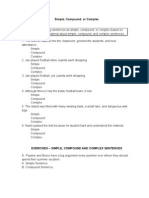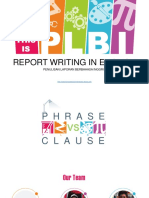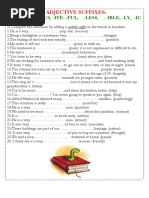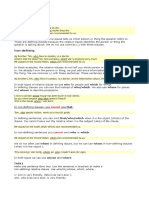Compound Nouns 1
Compound Nouns 1
Uploaded by
Anis SyazwaniCopyright:
Available Formats
Compound Nouns 1
Compound Nouns 1
Uploaded by
Anis SyazwaniCopyright
Available Formats
Share this document
Did you find this document useful?
Is this content inappropriate?
Copyright:
Available Formats
Compound Nouns 1
Compound Nouns 1
Uploaded by
Anis SyazwaniCopyright:
Available Formats
Compound Nouns A compound noun is a noun that is made with two or more words.
A compound noun is usually [noun + noun] or [adjective + noun], but there are other combinations (see below). It is important to understand and recognize compound nouns. Each compound noun acts as a single unit and can be modified by adjectives and other nouns. There are three forms for compound nouns:
1. open or spaced - space between words (tennis shoe) 2. hyphenated - hyphen between words (six-pack) 3. closed or solid - no space or hyphen between words (bedroom)
Here are some examples of compound nouns:
bus stop noun + noun fire-fly football full moon adjective + noun blackboard software breakfast washing machine Is this the bus stop for the number 12 bus? In the tropics you can see fire-flies at night. Shall we play football today? I always feel crazy at full moon. Clean the blackboard please. I can't install this software on my PC. We always eat breakfast at 8am.
verb(-ing)
+ noun
Put the clothes in the red washing machine.
swimming pool What a beautiful swimming pool! sunrise noun + verb(-ing) haircut train-spotting verb noun + preposition + prepositional check-out mother-in-law I like to get up at sunrise. You need a haircut. His hobby is train-spotting. Please remember that check-out is at 12 noon. My mother-in-law lives with us.
www.nuranissyazwani.blogspot.com
phrase Do you think the police accept money from the underworld? We need 10 truckfuls of bricks.
preposition + noun
underworld
noun
+ adjective
truckful
Pronunciation Compound nouns tend to have more stress on the first word. In the phrase "pink ball", both words are equally stressed (as you know, adjectives and nouns are always stressed). In the compound noun "golf ball", the first word is stressed more (even though both words are nouns, and nouns are always stressed). Since "golf ball" is a compound noun we consider it as a single noun and so it has a single main stress - on the first word. Stress is important in compound nouns. For example, it helps us know if somebody said "a GREEN HOUSE" (a house which is painted green) or "a GREENhouse" (a building made of glass for growing plants inside). British/American differences Different varieties of English, and even different writers, may use the open, hyphenated or closed form for the same compound noun. It is partly a matter of style. There are no definite rules. For example we can find:
y y y
container ship container-ship containership
If you are not sure which form to use, please check in a good dictionary. Plural forms of compound nouns In general we make the plural of a compound noun by adding -s to the "base word" (the most "significant" word). Look at these examples:
singular a school teacher one assistant headmaster the sergeant major a mother-in-law plural three school teachers five assistant headmasters some sergeants major two mothers-in-law
an assistant secretary of state three assistant secretaries of state
www.nuranissyazwani.blogspot.com
my toothbrush a woman-doctor a doctor of philosophy a passerby, a passer-by
our toothbrushes four women-doctors two doctors of philosophy two passersby, two passers-by
Note that there is some variation with words like spoonful or truckful. The old style was to say spoonsful or trucksful for the plural. Today it is more usual to say spoonfuls or truckfuls. Both the old style (spoonsful) and the new style (spoonfuls) are normally acceptable, but you should be consistent in your choice. Here are some examples:
old style plural (very formal) new style plural
teaspoonful 3 teaspoonsful of sugar 3 teasponfuls of sugar truckful bucketful cupful 5 trucksful of sand 2 bucketsful of water 4 cupsful of rice 5 truckfuls of sand 2 bucketfuls of water 4 cupfuls of rice
Some compound nouns have no obvious base word and you may need to consult a dictionary to find the plural:
y y y y y y
higher-ups also-rans go-betweens has-beens good-for-nothings grown-ups
Note that with compound nouns made of [noun + noun] the first noun is like an adjective and therefore does not usually take an -s. A tree that has apples has many apples, but we say an apple tree, not apples tree; matchbox not matchesbox; toothbrush not teethbrush. With compound nouns made of [noun + noun] the second noun takes an -s for plural. The first noun acts like an adjective and as you know, adjectives in English are invariable. Look at these examples:
www.nuranissyazwani.blogspot.com
long plural form becomes
plural compound noun [noun + noun] 100 apple trees
100 trees with apples
1,000 cables for telephones 1,000 telephone cables 20 boxes for tools 10 stops for buses 4,000 wheels for cars 20 tool boxes 10 bus stops 4,000 car wheels
www.nuranissyazwani.blogspot.com
You might also like
- Present and Past TensesDocument2 pagesPresent and Past TensesPopa IrinaNo ratings yet
- Vocabulary Practice Test 1 Answer KeyDocument3 pagesVocabulary Practice Test 1 Answer KeyLeah Ato AntioquiaNo ratings yet
- Complex Sentences ExercisesDocument3 pagesComplex Sentences Exercisesgogolee2013100% (1)
- 21-Infinitive and Infinitive PhraseDocument4 pages21-Infinitive and Infinitive PhraseNaing Win100% (1)
- Examples of English TensesDocument17 pagesExamples of English TensesKeerthi VasanNo ratings yet
- PrepositionsDocument5 pagesPrepositionsCinthyaNo ratings yet
- Prepositions - Grammar RulesDocument3 pagesPrepositions - Grammar RulesHhimanshu UmraoNo ratings yet
- 5 Sentences PatternsDocument2 pages5 Sentences PatternsKen Ralph EtabNo ratings yet
- Active Vs Passive VoiceDocument10 pagesActive Vs Passive VoiceRozita KamarudinNo ratings yet
- 1 Complete The Sentences With The Present Perfect Form of The Verbs in BracketsDocument2 pages1 Complete The Sentences With The Present Perfect Form of The Verbs in BracketsPaula Lilloy FedeleNo ratings yet
- Simple, Compound N ComplexDocument3 pagesSimple, Compound N ComplexYusmaliza YusoffNo ratings yet
- Stucture Word ClassesDocument10 pagesStucture Word ClassesDwiNo ratings yet
- Compound SentencesDocument4 pagesCompound SentencesMuhammad ElhalawanyNo ratings yet
- Comparison of AdjectivesDocument5 pagesComparison of AdjectivesJulie KangNo ratings yet
- GREAT!! Types of DeterminersDocument6 pagesGREAT!! Types of DeterminersRaphael Novos RumosNo ratings yet
- Reduced Forms AEDocument2 pagesReduced Forms AEelizabetaaNo ratings yet
- Report Writing in English: Penulisan Laporan Berbahasa InggrisDocument21 pagesReport Writing in English: Penulisan Laporan Berbahasa InggrisRiaNo ratings yet
- Phrasal VerbsDocument14 pagesPhrasal VerbsEla Singh ST0361100% (1)
- Present Past PerfectDocument7 pagesPresent Past PerfectMoni ScaltritoNo ratings yet
- VerbsDocument25 pagesVerbsTiba AlaniNo ratings yet
- Conditional SentencesDocument8 pagesConditional SentencesSaja Lolwa100% (1)
- Adjunct, Conjunct and Disjunct: Ex: (If at All Possible) I'll See You (Tomorrow) (After The Show) (Outside The MainDocument5 pagesAdjunct, Conjunct and Disjunct: Ex: (If at All Possible) I'll See You (Tomorrow) (After The Show) (Outside The Mainaouni alshariNo ratings yet
- Comparative and Superlative Adjectives - Article - OnestopenglishDocument6 pagesComparative and Superlative Adjectives - Article - OnestopenglishdianaNo ratings yet
- WC Punctuating With ApostrophesDocument2 pagesWC Punctuating With ApostrophesMian Hussain AhmadNo ratings yet
- Prepositions WorksheetDocument3 pagesPrepositions WorksheetjennikybookyNo ratings yet
- Relative ClausesDocument14 pagesRelative ClausesAlejandra SchlesingerNo ratings yet
- Few A Few Little and A LittleDocument2 pagesFew A Few Little and A LittleIva Waya VasiljevNo ratings yet
- Worksheet: Reported Speech StudentDocument4 pagesWorksheet: Reported Speech Studentامين الجيلاني100% (1)
- The Position of Adverbs in SentencesDocument2 pagesThe Position of Adverbs in SentencesCasimiro LuengoNo ratings yet
- Unit 29-ArticlesDocument15 pagesUnit 29-Articlesapi-252190418No ratings yet
- 12 April 2015 General B1 Exam Homes Houses Picture Description SpeakingDocument2 pages12 April 2015 General B1 Exam Homes Houses Picture Description SpeakingFlaviaNo ratings yet
- Advanced Grammar - PHRASESDocument15 pagesAdvanced Grammar - PHRASESTieu LinhNo ratings yet
- Gerunds and InfinitivesDocument10 pagesGerunds and InfinitivesNguyễn BìnhNo ratings yet
- English Tenses ExplainedDocument2 pagesEnglish Tenses ExplainedTaran ParchNo ratings yet
- Grammarism Ed Ing Adjectives Test 4 1189424Document2 pagesGrammarism Ed Ing Adjectives Test 4 1189424Royal Stars Drama AcademyNo ratings yet
- English Modal VerbsDocument9 pagesEnglish Modal VerbsPrincess BubblegumNo ratings yet
- PrepositionsDocument16 pagesPrepositionsJohn PascualNo ratings yet
- Adjective SuffixesDocument2 pagesAdjective SuffixesYulya TodosNo ratings yet
- If - Conditionals GrammarDocument3 pagesIf - Conditionals Grammarhue nguyenNo ratings yet
- Combining Sentences in English. Compound SentencesDocument27 pagesCombining Sentences in English. Compound SentencessamouNo ratings yet
- Relative Clauses 4Document7 pagesRelative Clauses 4Makedonka JovanovskaNo ratings yet
- ConjunctionsDocument4 pagesConjunctionsSamar HamadyNo ratings yet
- Pronoun Shortcut RulesDocument3 pagesPronoun Shortcut RulesnilvemangeshNo ratings yet
- NEW Total English: Elementary LevelDocument15 pagesNEW Total English: Elementary LevelEduardo Israel Sanchez Ayala100% (1)
- Comparative SuperlativeDocument16 pagesComparative SuperlativeAlice Anrriet100% (1)
- Relative ClausesDocument2 pagesRelative ClausesjsierrahNo ratings yet
- Nominalisation: Nominalising The VerbsDocument3 pagesNominalisation: Nominalising The Verbsd100% (1)
- 1) Simple Past TenseDocument26 pages1) Simple Past TenseHima BinduNo ratings yet
- The Participles 2Document13 pagesThe Participles 2krostinichu100% (2)
- InfinitivesDocument12 pagesInfinitivesdinejedidahNo ratings yet
- How To Describe A Sunny Day in A StoryDocument3 pagesHow To Describe A Sunny Day in A StoryPhương Linh Elsa0% (1)
- Gerunds & Infinitives: Infinitive: To V Gerund: V-IngDocument17 pagesGerunds & Infinitives: Infinitive: To V Gerund: V-IngDuc FilanNo ratings yet
- Tenses Test2Document3 pagesTenses Test2Esin ErdoğanNo ratings yet
- Sequence Words.Document2 pagesSequence Words.Diego AlbaNo ratings yet
- 'Will & Going To' - English Quiz & Worksheet PDFDocument2 pages'Will & Going To' - English Quiz & Worksheet PDFjorge figueroa NarvaezNo ratings yet
- PhrasesDocument21 pagesPhrasesjeremiah ochea100% (1)
- English Exercises - Comparative - Superlative PDFDocument2 pagesEnglish Exercises - Comparative - Superlative PDFJony PhyNo ratings yet
- No Mistakes Grammar Bites Volume XIV, "Superlatives and How We Use them Wrong"From EverandNo Mistakes Grammar Bites Volume XIV, "Superlatives and How We Use them Wrong"No ratings yet



























































